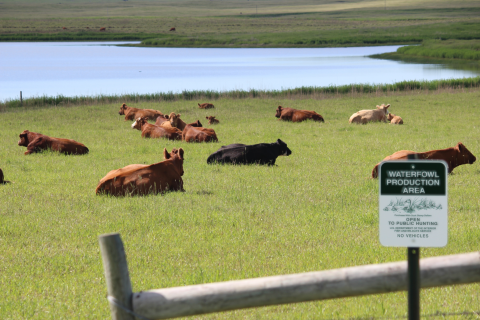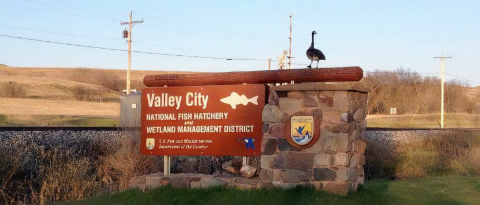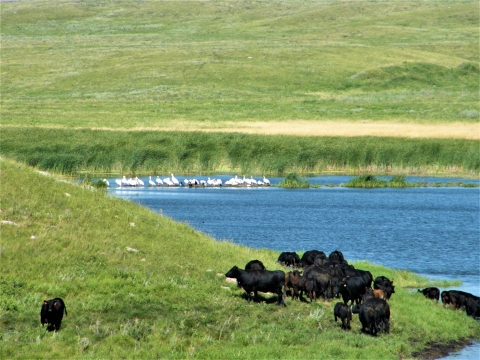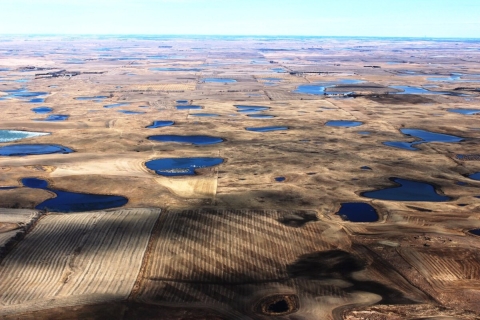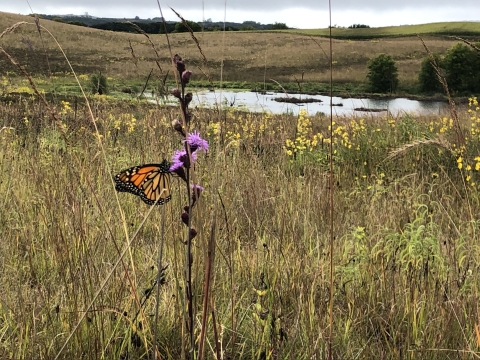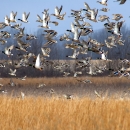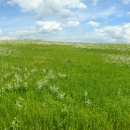What We Do
Wildlife conservation is at the heart of the National Wildlife Refuge System. It drives everything on U.S. Fish and Wildlife Service lands and waters managed within the Refuge System, from the purposes for which a National Wildlife Refuge is established to the recreational activities offered to the resource management tools used. Using conservation best practices, the Refuge System manages Service lands and waters to help ensure the survival of native wildlife species.
North America’s grassland biome is the continent’s most endangered major ecosystem. The decline in extent and quality of North American prairies coincides with decreasing populations of many animal species that depend on them and is among the most challenging conservation issues of this century. In states and provinces of the northern prairie region, for example, native prairie has declined 30% to 99% due mainly to conversion for agriculture. Roughly 222,000 acres of native mixed-grass and tallgrass prairie are managed by the U.S. Fish and Wildlife Service in North Dakota and South Dakota. These areas range from small isolated 40 acre grasslands surrounded by cropland to large contiguous areas such as National Wildlife Refuges.
On Service-owned lands across the District, management is focused on wetland habitat preservation and improvement, waterfowl production, maintenance of migration habitat, and provision of winter shelter for resident wildlife. The District also protects small wetlands and native grasslands by purchasing conservation easements from private landowners. In addition, District staff work with private landowners to assist with developing and restoring valuable wildlife habitat as part of the Partners for Fish and Wildlife program. Technical and cost-share assistance for agricultural and wildlife projects such as grazing systems, wetland restoration and creation, no-till planting, and grass seeding is available to private landowners.
Management and Conservation
Refuges use a host of scientifically sound management tools to address conservation challenges. These tools are all aimed at ensuring a balanced conservation approach to benefit both wildlife and people.
North Dakota has over 285,000 acres of habitat conserved as waterfowl production areas. These wetland and grassland habitats are managed through
livestock grazing, haying, and prescribed burning. These tools improve and maintain grasslands for waterfowl and other nesting birds, helping to sustain North America's waterfowl populations.
Grazing and prescribed burning are preferred tools for enhancing native grasses. When timed properly, both of these techniques can improve vigor and change the species composition of native grasses. Haying and raking can also improve the native and tame grasses. Haying and grazing activities are accomplished by private landowners who have special use permits.
On occasion, private landowners enter into cooperative farming agreements with the U.S. Fish and Wildlife Service. Under these agreements, old stands of planted grasslands are broken out and farmed for successive years and then seeded back to tame or native grass species.
Haying and Grazing
Haying and grazing are critical tools managers use to manage the grasslands. Refuge managers work together with local ranchers to mimic natural disturbances that were once caused by large prairie herds of free-ranging bison, antelope, and elk. Through haying and livestock grazing, invasive cool-season grasses and other invasive plants are stressed, which helps native grasses and forbs such as western wheatgrass, green needlegrass, blue grama, little bluestem, purple coneflowers, goldenrods and low-growing shrubs. Haying and grazing can greatly influence the structure structure
Something temporarily or permanently constructed, built, or placed; and constructed of natural or manufactured parts including, but not limited to, a building, shed, cabin, porch, bridge, walkway, stair steps, sign, landing, platform, dock, rack, fence, telecommunication device, antennae, fish cleaning table, satellite dish/mount, or well head.
Learn more about structure and diversity of grassland communities, which in turn, create the variety of areas needed for nesting upland birds.
Invasive Species
Invasive species are plants and animals that are not native to an area, and can cause economic or environmental harm. One of the largest threats to public lands in the United States, next to habitat loss, is the invasion of invasive plant and animal species. If left unchecked, invasive species invasive species
An invasive species is any plant or animal that has spread or been introduced into a new area where they are, or could, cause harm to the environment, economy, or human, animal, or plant health. Their unwelcome presence can destroy ecosystems and cost millions of dollars.
Learn more about invasive species can alter habitat and water quality.
Refuge managers use livestock grazing, burning, chemical application and insects to control invasive plants such as smooth bromegrass, Kentucky bluegrass, Canada thistle, absinth wormwood, leafy spurge, Russian olive, and Siberian elm trees.
Prescribed Fire
Prairies in the northern Great Plains evolved with interacting grazing (by bison, elk, antelope, small mammals, and insects) and fire disturbances (started by lightning and Native Americans). These events, along with drought, shaped grassland plant and animal communities. Woodland and forest, for example, were relatively uncommon before homesteading of North Dakotas vast grasslands. Before this European settlement of North Dakota, fires were common during all months of the year, reoccurring roughly every 5–10 years in our area – this kept grassland mostly free from trees. These natural disturbances ended by the early 1900s, however, when bison were extirpated and most prairie fires were suppressed.
Today, prescribed fire and prescribed grazing (by cattle) are used by refuge managers to mimic or recreate natural events by bison and Native Americans that occurred before 1900. Annually, about 25,000-50,000 acres of grassland are periodically burned on national wildlife refuges in the Dakotas and eastern Montana. Fire is used primarily to maintain or improve habitat for wildlife, restore native vegetation, and reduce accumulated fuels (dead vegetation) associated with catastrophic wildfire.
Our Services
-Go to bottom of this page for current open opportunities-
Visitor Services
The headquarters office for the District is located at the Valley City National Fish Hatchery, two miles northwest of Valley City, North Dakota along the Sheyenne River. Stop by our office during normal business hours to learn more about our District.
There are no visitor facilities located at individual waterfowl production areas.
Cooperative Agriculture, Haying, and Grazing
U.S. Fish & Wildlife Service partners with farmers and ranchers to accomplish our grassland and wildlife management objectives. Cooperative agreements between the U.S. Fish and Wildlife Service and farmers or ranchers may permit grazing, growing crop, and haying. We regularly utilize agricultural practices to manage and enhance habitat for wildlife.
If you are interested in grazing livestock, harvesting hay, or cooperatively farming on Valley City Wetland Management District lands please contact Kurt Tompkins at Kurt_Tompkins@fws.gov or (701)845-3466. For currently available services in grazing, haying, or cooperatively farming see below.
Wetland Easement
A wetland easement is a legal agreement signed with the United States of America, through the U.S. Fish and Wildlife Service, that pays landowners a lump-sum of money to permanently protect wetlands. Landowners who sell a wetland easement to the Service agree that wetlands protected by an easement cannot be drained, filled, leveled, or burned. If these wetlands dry up naturally, they can be farmed, grazed or hayed.
To find out more click on the Wetland Easements tab below.
To check what is under wetland easement click here.
To see if you qualify and to have a evaluation done call Matt Parvey at (701)845-3466.
Grassland Easements
A grassland easement is a legal agreement signed with the United States of America, through the U.S. Fish & Wildlife Service, that pays landowners a lump-sum of money to permanently keep their land in grass. Landowners who sell a grassland easement to the Service agree to maintain permanent vegetative cover such as forbs, grasses, and low shrubs. Land covered by a grassland easement may not be cultivated. Mowing, haying and grass seed harvesting are restricted and may be delayed until after July 15 each year. This specific restriction is designed to help grassland nesting species, such as ducks and pheasants, complete their nesting before the grass is disturbed.
To find out more click on the Grassland Easements tab below. To see if you qualify and to have a evaluation done call Matt Parvey at (701)845-3466.
Currently Open Service Opportunities
Law Enforcement
U.S. Fish and Wildlife Service law enforcement officers have a wide variety of duties and responsibilities. Officers help visitors understand and obey wildlife protection laws. They work closely with state and local government offices to enforce federal, state and refuge hunting regulations that protect migratory birds and other game species from illegal take and preserve legitimate hunting opportunities. Other duties include patrolling closed areas or wilderness areas, maintaining relationships with neighboring landowners, maintaining refuge boundaries and participating in public events related to refuge issues.
Laws and Regulations
Management actions on national wildlife refuges are bound by many mandates including laws and executive orders.

